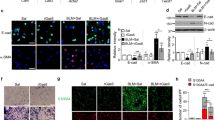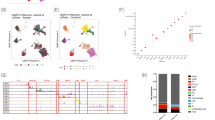Abstract
Hepatic fibrosis is associated with the activation of stellate cells (HSCs), the major source of extracellular matrix (ECM) proteins. Transforming growth factor-β (TGF-β), signaling via Smad3, is the most profibrogenic cytokine and the major promoter of ECM synthesis. Halofuginone, an inhibitor of liver fibrosis, inhibits TGF-β-dependent Smad3 phosphorylation in human HSCs in culture. We have used transcriptional profiling to evaluate the effect of halofuginone on gene expression during the progression of thioacetamide (TAA)-induced liver fibrosis in the rat and have focused on genes that are associated with TGF-β. TAA treatment causes alterations in the expression of 7% of liver genes. Halofuginone treatment prevents the changes in the expression of 41% of these genes and results in the inhibition of HSC activation and collagen synthesis. During the early stages of the disease, halofuginone affects genes involved in alcohol, lipid, protein, and phosphate metabolism and cell adhesion and, at later stages, in the cell cycle (cell development, differentiation, cell proliferation, and apoptosis). The activation of TGF-β-dependent genes, such as tartrate-resistant acid phosphatase, its putative substrate osteopontin, stellate cell activation-association protein, and fibrillin-1, during chemically induced fibrosis is prevented by halofuginone. This study thus highlights the role of TGF-β signaling in liver fibrosis and especially its potential for pharmacological intervention. Halofuginone, which has demonstrated efficacy and tolerance in animals and humans, could become an effective and novel therapy for liver fibrosis.








Similar content being viewed by others
References
Bataller R, Brenner DA (2005) Liver fibrosis. J Clin Invest 115:209–218
Bostrom K, Zebboudj AF, Yao Y, Lin TS, Torres A (2004) Matrix GLA protein stimulates VEGF expression through increased transforming growth factor-beta1 activity in endothelial cells. J Biol Chem 279:52904–52913
Bruck R, Genina O, Aeed H, Alexiev R, Nagler A, Pines M (2001) Halofuginone to prevent and treat thioacetamide-induced liver fibrosis in rats. Hepatology 33:379–386
Costamagna E, Garcia B, Santisteban P (2004) The functional interaction between the paired domain transcription factor Pax8 and Smad3 is involved in transforming growth factor-beta repression of the sodium/iodide symporter gene. J Biol Chem 279:3439–3446
Dooley S, Hamzavi J, Breitkopf K, Wiercinska E, Said HM, Lorenzen J, Peter Ten Dijke P, Axel M, Gressner AM (2003) Smad7 prevents activation of hepatic stellate cells and liver fibrosis in rats. Gastroenterology 125:178–191
Flanders KC (2004) Smad3 as a mediator of the fibrotic response. Int J Exp Pathol 85:47–64
Gnainsky Y, Spira G, Paizi M, Bruck R, Nagler A, Naffer Abu-Amar S, Geiger B, Genina O, Monsonego-Ornan E, Pines M (2003) Halofuginone—an inhibitor of collagen synthesis by rat stellate cells—stimulates insulin-like growth factor-binding protein 1 synthesis by hepatocytes. J Hepatol 40:269–277
Gnainsky Y, Spira G, Paizi M, Bruck R, Nagler A, Genina O, Taub R, Halevy O, Pines M (2006) The involvement of the tyrosine phosphatase early gene of liver regeneration (PRL-1) in cell cycle and in liver regeneration and fibrosis–effect of halofuginone. Cell Tissue Res 324:385–394
Inagaki Y, Mamura M, Kanamaru Y, Greenwel P, Nemoto T, Takehara K, Dijke P ten, Nakao A (2001) Constitutive phosphorylation and nuclear localization of Smad3 are correlated with increased collagen gene transcription in activated hepatic stellate cells. J Cell Physiol 187:117–123
Iredale JP (2001) Hepatic stellate cell behavior during resolution of liver injury. Semin Liver Dis 21:427–436
Kawada N, Kristensen DB, Asahina K, Nakatani K, Minamiyama Y, Seki S, Yoshizato K (2001) Characterization of a stellate cell activation-associated protein (STAP) with peroxidase activity found in rat hepatic stellate cells. J Biol Chem 276:25318–25323
Kmiec Z (2001) Cooperation of liver cells in health and disease. Adv Anat Embryol Cell Biol 161:1–151
Koseki T, Gao Y, Okahashi N, Murase Y, Tsujisawa T, Sato T, Yamato K, Nishihara T (2002) Role of TGF-beta family in osteoclastogenesis induced by RANKL. Cell Signal 14:31–36
Kristensen DB, Kawada N, Imamura K, Miyamoto Y, Tateno C, Seki S, Kuroki T, Yoshizato K (2000) Proteome analysis of rat hepatic stellate cells. Hepatology 32:268–277
Lang P, Andersson G (2005) Differential expression of monomeric and proteolytically processed forms of tartrate-resistant acid phosphatase in rat tissues. Cell Mol Life Sci 62:905–918
Lareu MV, Alvarez-Prechous A, Pardinas C, Concheiro L, Carracedo A (1992) Genetic markers in alcoholic liver cirrhosis. Hum Hered 42:235–241
Lee SH, Seo GS, Park YN, Yoo TM, Sohn DH (2004) Effects and regulation of osteopontin in rat hepatic stellate cells. Biochem Pharmacol 68:2367–2378
Lorena D, Darby IA, Reinhardt DP, Sapin V, Rosenbaum J, Desmouliere A (2004) Fibrillin-1 expression in normal and fibrotic rat liver and in cultured hepatic fibroblastic cells: modulation by mechanical stress and role in cell adhesion. Lab Invest 84:203–212
McGaha TL, Kodera T, Spiera H, Stan AC, Pines M, Bona CA (2002a) Halofuginone inhibition of COL1A2 promoter activity via a c-Jun-dependent mechanism. Arthritis Rheum 46:2748–2761
McGaha TL, Phelps RG, Spiera H, Bona C (2002b) Halofuginone, an inhibitor of type-I collagen synthesis and skin sclerosis, blocks transforming-growth-factor-beta-mediated Smad3 activation in fibroblasts. J Invest Dermatol 118:461–470
Nagler A, Pines M (1999) Topical treatment of cutaneous chronic graft versus host disease (cGvHD) with halofuginone: a novel inhibitor of collagen type I synthesis. Transplantation 68:1806–1809
Nagler A, Ohana M, Shibolet O, Shapira MY, Alper R, Vlodavsky I, Pines M, Ilan Y (2004) Suppression of hepatocellular carcinoma growth in mice by the alkaloid coccidiostat halofuginone. Eur J Cancer 40:1397–1403
Nakatani K, Okuyama H, Shimahara Y, Saeki S, Kim DH, Nakajima Y, Seki S, Kawada N, Yoshizato K (2004) Cytoglobin/STAP, its unique localization in splanchnic fibroblast-like cells and function in organ fibrogenesis. Lab Invest 84:91–101
Pines M, Knopov V, Genina O, Lavelin I, Nagler A (1997a) Halofuginone, a specific inhibitor of collagen type I synthesis, prevents dimethylnitrosamine-induced liver cirrhosis. J Hepatol 27:391–398
Pines M, Vlodavsky I, Nagler A (1997b) Halofuginone—a novel anti-fibrotic therapy. Gen Pharmacol 30:445–450
Pines M, Vlodavsky I, Nagler A (2000) Halofuginone: from veterinary use to human therapy. Drug Dev Res 50:371–378
Pines M, Domb A, Ohana M, Inbar J, Genina O, Alexiev R, Nagler A (2001) Reduction in dermal fibrosis in the tight-skin (Tsk) mouse after local application of halofuginone. Biochem Pharmacol 62:1221–1227
Pines M, Snyder D, Yarkoni S, Nagler A (2003) Halofuginone to treat fibrosis in chronic graft versus host disease and scleroderma. Biol Blood Marrow Transplant 9:417–425
Roberts AB, Russo A, Felici A, Flanders KC (2003) Smad3: a key player in pathogenetic mechanisms dependent on TGF-β. Ann N Y Acad Sci 995:1–10
Rockey DC (2005) Antifibrotic therapy in chronic liver disease. Clin Gastroenterol Hepatol 3:95–107
Ruel M, Bianchi C, Khan TA, Xu S, Liddicoat JR, Voisine P, Araujo E, Lyon H, Kohane IS, Libermann TA, Sellke FW (2003) Gene expression profile after cardiopulmonary bypass and cardioplegic arrest. J Thorac Cardiovasc Surg 126:1521–1530
Schmidt M, Gerlach F, Avivi A, Laufs T, Wystub S, Simpson JC, Nevo E, Saaler-Reinhardt S, Reuss S, Hankeln T, Burmester T (2004) Cytoglobin is a respiratory protein in connective tissue and neurons, which is up-regulated by hypoxia. J Biol Chem 279:8063–8069
Schnabl B, Kweon YO, Frederick JP, Wang XF, Rippe RA, Brenner DA (2001) The role of Smad3 in mediating mouse hepatic stellate cell activation. Hepatology 34:89–100
Schuppan D, Ruehl M, Somasundaram R, Hahn EG (2001) Matrix as a modulator of hepatic fibrogenesis. Semin Liver Dis 21:351–372
Shalitin N, Schlesinger H, Levy MJ, Kessler E, Kessler-Icekson G (2003) Expression of procollagen C-proteinase enhancer in cultured rat heart fibroblasts: evidence for co-regulation with type I collagen. J Cell Biochem 90:397–407
Sharan R, Maron-Katz A, Shamir R (2003) Click and expander: a system for clustering and visualizing gene expression data. Bioinformatics 19:1787–1799
Shi X, Bai S, Li L, Cao X (2001) Hoxa-9 represses transforming growth factor-beta-induced osteopontin gene transcription. J Biol Chem 276:850–855
Shi YY, Wang HC, Yin YH, Sun WS, Li Y, Zhang CQ, Wang Y, Wang S, Chen WF (2005) Identification and analysis of tumour-associated antigens in hepatocellular carcinoma. Br J Cancer 92:929–934
Spira G, Mawasi N, Paizi M, Anbinder N, Genina O, Alexiev R, Pines M (2002) Halofuginone, a collagen type I inhibitor improves liver regeneration in cirrhotic rats. J Hepatol 37:331–339
Uemura M, Swenson ES, Gaca MD, Giordano FJ, Reiss M, Wells RG (2005) Smad2 and Smad3 play different roles in rat hepatic stellate cell function and {alpha}-smooth muscle actin organization. Mol Biol Cell 16:4214–4224
Van de Casteele M, Roskams T, Van der Elst I, Pelt JF van, Fevery J, Nevens F (2004) Halofuginone can worsen liver fibrosis in bile duct obstructed rats. Liver Int 24:502–509
Xavier S, Piek E, Fujii M, Javelaud D, Mauviel A, Flanders KC, Samuni AM, Felici A, Reiss M, Yarkoni S, Sowers A, Mitchell JB, Roberts AB, Russo A (2004) Amelioration of radiation-induced fibrosis: inhibition of transforming growth factor-beta signaling by halofuginone. J Biol Chem 279:15167–15176
Yee KO, Connolly CM, Pines M, Lawler J (2006) Halofuginone inhibits tumor growth in the polyoma middle T antigen mouse via a thrombospondin-1 independent mechanism. Cancer Biol Ther 5:218–224
Author information
Authors and Affiliations
Corresponding author
Additional information
This study was supported by the Israel Science Foundation (ISF; 537/01), Canadian Institutes of Health Research (MOP-68836), and NIH grants U01 DK58739 and R21 CA108303 and is a contribution from the Agricultural Research Organization, The Volcani Center, Bet Dagan, Israel (no. 481/05).
Rights and permissions
About this article
Cite this article
Gnainsky, Y., Kushnirsky, Z., Bilu, G. et al. Gene expression during chemically induced liver fibrosis: effect of halofuginone on TGF-β signaling. Cell Tissue Res 328, 153–166 (2007). https://doi.org/10.1007/s00441-006-0330-1
Received:
Accepted:
Published:
Issue Date:
DOI: https://doi.org/10.1007/s00441-006-0330-1




